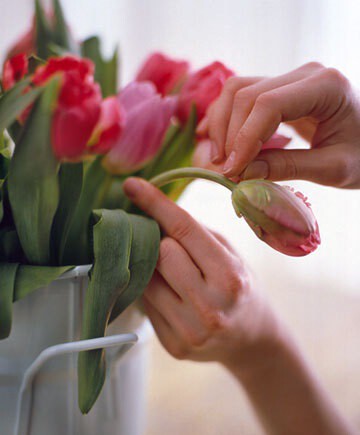
Most cut flowers need only minimal conditioning to look their best. A few flowers, however, require special treatment.
Woody (Lilacs, Dogwood, Azaleas, Camellias, Forsythia)
These stems can be more difficult to cut than others. Use sharp scissors or shears to make a clean cut at a 45-degree angle; ragged cuts can damage tissues and decrease water intake.
Bulbs (Tulips, Daffodils, Crocuses, Grape Hyacinth)
When preparing to arrange flowers that grow from bulbs, cut off the firm white portion at the bottom of the stem to help the flower draw more water. (If you are buying these flowers from a florist, this is usually done for you.) Before arranging, wrap stems in brown paper or newsprint, secure with twine or a rubber band, and place in water; this will help keep the blooms from drooping. Daffodils should always be arranged by themselves because their stems emit a substance that is toxic to other cut flowers.
Milky (Poppies, Hollyhocks)
Condition plants that exude milky sap separately before arranging them with other flowers. Change water frequently.
Roses
If you buy roses from a florist, they probably will have already been shorn of their thorns. At home, you can pare them with a sharp knife or rose dethorner; work from the top down to put less stress on the stem. If flowers look limp, revive them by submerging them in a bath of cool water and covering the stems with a towel; to keep them submerged, tie the stems together, and attach an anchor, such as a fishing weight.